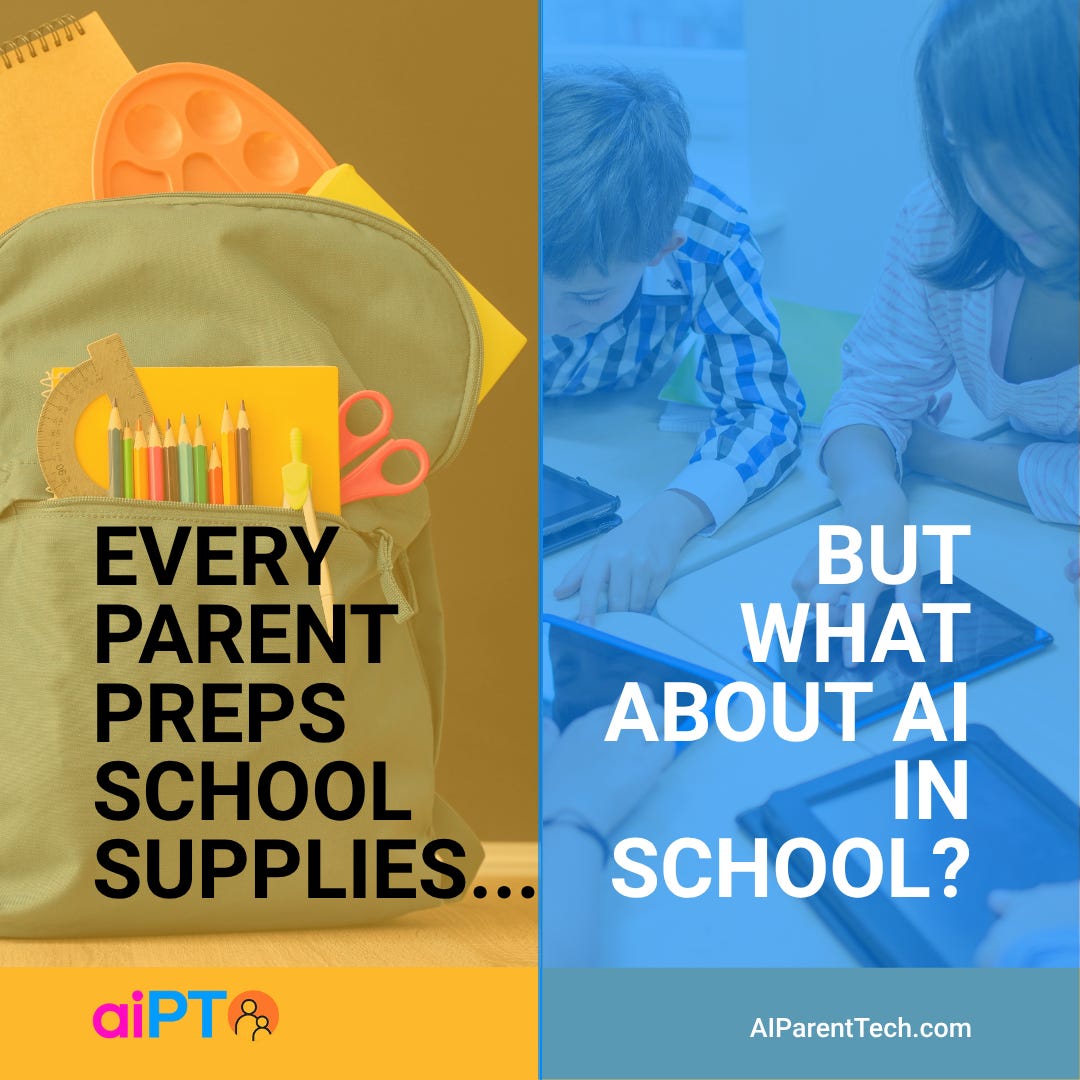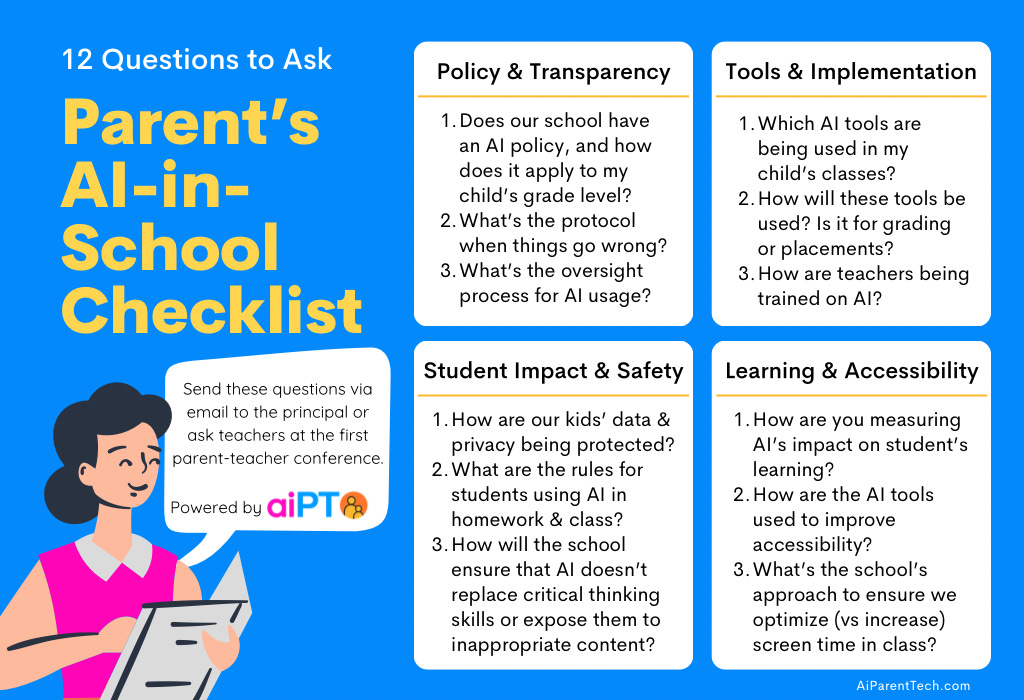What to Expect When AI Shows Up in School
What parents need to know about AI in schools: how teachers are using AI, where regulations stand, and what parents should be ready for on day one
Back-to-school with AI: Parents Preparation Series Part 1
With school just weeks away, my inbox is filling up with the usual back-to-school reminders: health forms, supply lists, orientation dates.
We’ve had the familiar conversations about managing my child’s anxiety about starting a new grade, making new friends, and having new teachers.
But this year, there’s a new anxiety for me: How will AI show up in my child’s classroom?
TL;DR for busy parents
AI in entering our kids’ classrooms faster than most schools can regulate. Some teachers are using it enthusiastically, others are deeply skeptical. Federal guidance is increasing, but clear, school-wide policies are lagging. Meanwhile, kids are already using AI, often without adult oversight or guidance. (Read more about what’s driving AI adoption in schools)
Here’s what it means for your family:
Don’t expect consistency. AI rules will vary class by class.
AI-powered tools may change how your child does homework, gets feedback, or interacts with content.
Risks like false flagging, privacy gaps, and deepfake misuse are real and still remain.
We, as parents, can do something. I share practical questions you can ask to your school to get clarity and advocate for your child. Click here to go directly to those questions.
How We Got Here
We’ve all read a lot of AI headlines this year. From the launch of “Stargate” project, Google Gemini for Education, to a nationwide push for classroom AI adoption.
Too often, half baked education technologies rush into our classrooms as part of a broader tech arms race.
But education shouldn’t be seen as a race. It should be a journey for meaningful growth.
Meanwhile our education system is already struggling. Recent data shows the US reading and math scores have dropped (5-point and 7-point respectively) between 2020-2022, which some say are attributed to COVID1.
Many hope that this AI wave will help solve these challenges. Whether it will help or create more problems remains to be seen.
The Current Reality: Fragmented and Unguided Adoption Outpacing School Rules
All of the push for AI is wrapped in good intentions. But good intentions are not enough. We need intentional design and careful implementation.
Because here’s the reality faced by most classrooms: Lack of clarity and fragmented adoptions by teachers and students.
Most Schools Still Lack AI Policies But That’s Changing
We currently have 26 states (plus Puerto Rico) with AI guidance for K-12, doubling from only 13 in March 2025.2
While the percentage of U.S. schools and districts with a formal AI policy increased from 20% in 2024 to 40% in 2025, the rate remains lower in many rural or under-resourced districts.3
In contrast, some schools have pioneered AI adoption.
Gwinnett County Public Schools in Georgia: actively piloting AI readiness and integrating it into student learning across all grade levels4
Alpha Schools (private school): uses an AI-driven learning platform to allow students to complete their core academic work in just two hours a day.
The Dilemma Faced By Educators
Teachers’ experiences with AI are sharply divided, shaped by personal values, ethical concerns, and uneven institutional support.
Some educators have embraced these tools.
60% of U.S. public school teachers used AI in their work last year, with many reporting time savings of up to six hours per week (Gallup).5
About 61% said AI gave them better insights into student learning data, and 57% cited improvements in grading and student feedback (Gallup).
While others have significant skepticism and concern (Pew).6
Only 6% of teachers think AI does more good than harm in K-12 education;
A quarter (25%) say it does more harm than good;
The rest either see an equal mix or remain unsure.
~28% of teachers actively oppose using AI tools in the classroom, citing concerns about critical thinking, cheating, safety, and environmental cost (Gallup).
Kids Are Adopting AI Faster Than Schools Can Regulate
At the same time, our kids are already using AI in huge numbers, often without clear rules or oversight.
In 2024, 70% of US teens have used at least one GenAI tool for schoolwork or leisure.7 That number is likely higher now.
While in the UK, A 2025 survey found almost half of all students had already used AI while in secondary school.8
Meanwhile, only 37% of parents were aware that their teens were using AI in the US in 2024.
AI Safety Concerns Are Emerging in Schools
Meanwhile, safety risks are growing alongside student AI adoption.
In the past year, the National Center for Missing & Exploited Children (NCMEC) fielded over 21 million CyberTipline reports, with a significant portion involving child sexual abuse material (CSAM).9
Recent Stanford policy briefs warn:10
Generative AI and “nudify” or deepfake apps have made it alarmingly simple even for students to create (and spread) fake explicit images involving minors,
This raises raising new threats within school communities.
These internal concerns (lack of policies, educators uncertainty, and blurred lines around student use) are compounded by external forces pushing AI adoption forward.
AI adoption is accelerating whether our teachers, schools, and kids are ready.
External Forces Driving the AI Rush
As a parent, I wish schools had more time to slow down and figure this out.
But sweeping external pressures, like new government rules, funding initiatives, and waves of AI-powered tools, are rapidly shaping our children’s classroom experience this year.
The government push and funding
We've seen a series of top-down push from the federal government on the AI front in school this year.
Federal guidance released April 2025, emphasized AI adoption in education,
Direct outreach to educators in the “Letter to Colleagues” AI in School Guidance on July 22,
The Presidential AI Challenge for K-12 Students just launched a few days ago.
Remember, some of these Federal priorities are tied to funding.
Existing federal grant funds can now be used for AI initiatives:
AI-based instructional materials,
intelligent tutoring systems, and
career exploration tools.
The only caveat is they must align with statutory requirements and emphasize the five core responsible use principles: educator-led, ethical, transparent, equity-focused and privacy-compliant.
In an already scarce public education ecosystem, funding will define where things will change.
If you have time to review further the guidance, consider submitting your input because the government has opened it for public comment until August 21st.
New AI-Powered Education Tools
The education technology market is projected to hit $20B by 2027. Certainly expect more AI-powered education tools to show up in our classrooms.
Even if there’s no “new tool”, the existing tools already in your classrooms are starting to add AI features.
Google recently announced Gemini for education, which has over 30 AI tools, is now free for all schools, educators, and students.
Canvas has integrated Google's Gemini AI to offer features like a "Smart Search" to find course content and "Discussion Summary" to help instructors quickly understand key themes in student conversations.
Other large platforms like D2L Brightspace and Blackboard also have introduced their own AI-powered tools.
Even OpenAI recently released their learning mode, trying to compete in the market.
While some aim to assist teachers with course creation, rubric development, and the generation of test questions, some tools, like Khanmingo and MagicSchool, aim to directly interact with students.
Global AI Race
Around the world, countries such as China, Singapore, and South Korea are moving quickly to embed AI education into their school systems, viewing AI literacy as critical for economic competitiveness and future job markets.
This global urgency partly shapes U.S. education policies and underscores the importance of preparing our children today, even as local adoption varies widely.
What Does It Mean To Your Family?
Let me be frank, this is where it gets more complicated for parents, like you and me.
Don’t expect a uniform implementation of AI in each classrooms
Even as more schools create their own AI guidance or policy, the implementation will vary.
And it should vary to a certain extent, because of local context, applicable regulations, and, most importantly, the needs of the class will differ.
If you are keen to learn more about what your state or district potential will do, I recommend visiting AI for Education State guidance breakdown here.
Classroom experience will evolve
Think Google’s Project Astra tutoring our kids through chemistry problems or Khanmingo providing 24/7 personalized support whenever our kids struggle.
Or that instead of waiting for their teachers’ feedback, they can get immediate personalized AI feedback.
While we won’t see an immediate and stark change in the beginning, the possibilities do seem endless, especially if we consider personalized learning and assisted technology.
I do wonder, with all the promise of AI tools, how will our schools still prioritize human interaction at the core of it.
Because nothing is better than a meaningful connection between a teacher and their students.
Homework expectations will change too
Your child might use AI to brainstorm ideas in English class. Then, be flagged for using AI in History class.
Without clear school-wide policies, our kids may be navigating inconsistent rules and be penalized for the lack of one.
A high schooler in my recent youth panel shared that her homework essay was falsely flagged as AI generated. Our kids could face this same scenario this year.
Sometimes the line of whether our kids are “learning” or “cheating” can be blurry, especially when there is no clear school guidance on AI use.
So, before you say yes whenever your 7th grader asked if they can use AI to research a topic for their report, we not only need to consider OUR family values, we have to check what that subject teacher’s AI policy is.
The risks of our child encountering false or dangerous AI-generated content or eroding their critical thinking skills are still present
Unfortunately, these risks cannot be completely mitigated.
In my previous article, I laid out what the sciences say and still don't know about the impact of AI. There is still plenty of unknown of the long impact of using AI to our mind because the science is still keeping up.
I shared a lot about how I feel in preparing our child to THINK critically about AI-generated output and keeping their brain/ agency in charge when using AI.
It’s going to be another factor in our balancing act as a parent.
So, What Can We Do? Here’s 12 Questions to Ask Your School
As you’ve realized by now, our educators and schools are also figuring this out as they go.
This means we, as parents, have to step up as informed advocates for our children.
The first step is engaging our educators and asking for transparency from the school.
So, I’ve developed a list of questions that we can ask of our schools regarding their AI implementation. You can send this via email to the principal or ask them at the first parent-teacher conference.
Policy and Transparency
Does our school have an AI policy or guideline, and how does it apply to my child’s grade level?
What's the protocol when things go wrong?
What’s the oversight process of AI usage?
AI Tools and Implementation
Which AI tools are being used in my child’s classes?
How will these tools be used? Will it be used for high-stakes decisions like grading or placements?
How are teachers being trained on AI?
Student Impact & Safety
How are our kids’ data and privacy being protected?
What are the rules for students using AI in homework and class work?
How will the school ensure that AI doesn’t replace critical thinking skills or expose them to inappropriate content?
Learning & Accessibility
How are you measuring AI’s impact on student’s learning?
How are the AI tools used to improve accessibility, such as assisted tech, language translation?
What’s the school’s approach to ensure we optimize screen time in the classroom vs increase them with adoption of AI tools?
These questions aren’t exhaustive, but they are the first step in ensuring AI enhances rather undermine our children’s education.
I’ve made it into an infographic so you can save and share them with other parents in your school!
Be A Healthy Skeptic
Here’s a thought to sit with:
Remember the time you learn the most, what exactly made you learn a lot?
Was it the teacher? Topic? Classroom environment?
One tool would not change everything.
You can and should choose for yourself whether and how you are going to use AI. That goes for our kids too.
Our kids need to be able to decide and own the decisions as to how, when, where, and why to use AI.
It doesn’t always mean a total AI adoption or conforming to viral trends. But rather meaningful adaption of where AI might have an appropriate place in the classroom and our home.
I still have concerns about AI in my child’s classroom but now I have a plan. And so do you.
Forward these 12 questions to your PTO/PTA WhatsApp or email your school today.
If you miss my previous series on AI 101 for parents, click here to see the compilation of aiPTO resources.
Stay tuned as for the next couple of weeks I will continue my back to school series.
Coming soon:
Comparison and review of AI powered ed tech tools
Having a meaningful AI conversation with your child before going to back to school
How to collaborate and keep our schools accountable.
Dhani
NAEP Long-Term Trend Assessment Results: Reading and Mathematics https://www.nationsreportcard.gov/highlights/ltt/2022/
https://www.aiforeducation.io/ai-resources/state-ai-guidance
https://discover.carnegielearning.com/hubfs/PDFs/Whitepaper%20and%20Guide%20PDFs/2025-AI-in-Ed-Report.pdf
https://www.gcpsk12.org/news-details/~board/news-releases/post/gcps-implementing-comprehensive-guidance-for-the-ethical-use-of-ai
https://www.gallup.com/analytics/659819/k-12-teacher-research.aspx
https://www.pewresearch.org/short-reads/2024/05/15/a-quarter-of-u-s-teachers-say-ai-tools-do-more-harm-than-good-in-k-12-education/
https://www.commonsensemedia.org/press-releases/new-report-shows-students-are-embracing-artificial-intelligence-despite-lack-of-parent-awareness-and
https://www.hepi.ac.uk/2025/02/26/student-generative-ai-survey-2025/
https://www.missingkids.org/gethelpnow/cybertipline/cybertiplinedata
https://hai.stanford.edu/assets/files/hai-policy-brief-addressing-ai-csam.pdf







What a comprehensive review, Dhani.
What really strikes me is how rapidly AI is being deployed — with little consistency and an overwhelming push to move forward, ready or not.
In several of my roles, I worked closely with IT and was also responsible for both legacy and modern process control systems. In each of those areas, change control was critical. Before implementing anything new, it was thoroughly tested. And if something went wrong, we had a clear rollback plan. With software, that kind of disciplined approach is not only possible — it’s expected.
But in the case of AI in education, that kind of structure seems completely absent. Every new update brings "improvements" — not on an annual cycle like a new iPhone, but sometimes week to week. And when AI misfires or produces something problematic, the tendency is to dive into it further rather than pause. Just recently, there was an example of Grok doing exactly that.
So with this kind of backdrop, what exactly is the value being added? What are the learning objectives? How is AI being integrated into the curriculum?
The checklist for parents you shared is fantastic — copy, paste, send it to the school and demand answers. Because if AI adoption were happening within a stable system, those answers would already exist — posted on government or school board websites. But they don’t. Because AI is evolving every day.
To me, education should be pushing back. Slow down. Let’s say: “This year, we’re adopting A, B, and C.” Then we evaluate. We see how the transition goes. And if it works, we look at D, E, and F next year.
Think about how educational programs have traditionally worked — structured lesson plans, committee reviews, scheduled rollouts, incremental changes based on continuous improvement. This? This feels like chaos.
Students won’t know the boundaries. Teachers might not either. But everyone seems to be pushing for more, faster.
Your piece does a wonderful job of exploring the public's sentiment, where the federal and state and local boards are at. Your giving parents the key insights they need. Well researched, well presented, well done!